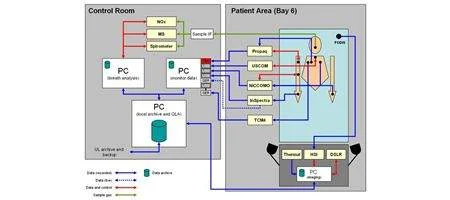British engineers have built a £1 million Star Trek-style ‘sick bay’ for the National Health Service, debuting at the Leicester Royal Infirmary’s accident and emergency department.

Designed to detect everything from bruising to cancer, the unit was developed as a byproduct of a joint project with NASA aimed at detecting the presence of life on Mars.
The unit is equipped with a set of instruments which analyze a patient’s breath, as well as another set that uses visual imaging to examine a patient’s skin. A third suite of monitors looks inside the body and measures blood-flow and oxygenation in real-time.
The team believes the equipment can be used to diagnose over 40 diseases, from sepsis through to bacterial infections such as C. Difficile and some cancers.
It’s the first time all these technologies have been brought together in an integrated way – and developing it involved scientists working in space research, emergency medicine, engineering and IT.
“We are replacing doctors’ eyes with state-of-the-art imaging systems, replacing the nose with breath analysis, and the ‘feel of the pulse’ with monitoring of blood flow using ultra sound technology and measurement of blood oxygen levels,” says professor Mark Sims, a University of Leicester space scientist.
“In the old days, it used to be said that a consultant could walk down a hospital ward and smell various diseases as well as telling a patient’s health by looking at them and feeling their pulse. What we are doing is a high tech version of that in order to help doctors to diagnose disease.”
Human breath contains a range of volatile organic compounds from bodily processes, whicih can be identified by a real-time mass spectrometer, and which provide clues to a wide range of diseases.
“An obvious example is ketones, which we detect in the breath of diabetics during hypoglycaemia,” says Sims.
“But there are also chemicals that can or could be used to indicate conditions such as asthma, sepsis, liver disease, heart disease, and several types of cancer.”
He says the same technology can be used to analyse urine and faeces.
The project came about through the development of a device called the Life Marker Chip for the ExoMars space mission, which will look for organic molecules in samples from below the surface of Mars.
Other space technology used in the project includes the imaging equipment used to gather information from patients, using visible light wavelengths as well as infra-red, and a thermal imagerthat examines patients’ surface and core temperatures.
Comparing the two temperatures can reveal disease because one response to illness is to withdraw blood from peripheral parts of the body.
Meanwhile, multi-spectral and hyper-spectral imagers can detect subtle changes in skin colour, showing, for example, liver disease, shock-induced poor circulation, early stage bruising and skin cancers.
“Ultimately in the longer term we would aim to work towards something like the ‘tricorder’ device seen in futuristic science series like Star Trek. What we are developing so far is more like a first attempt at the medical bed in the sci-fi series,” says Sims.
“It is hard to predict how this work will develop. But ten years from now it could be routine for diagnostic technology to be combined in this way.”






